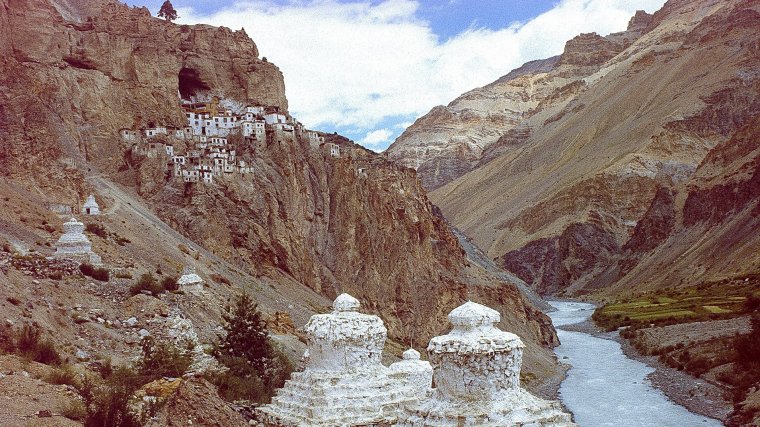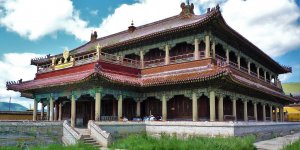| Travel / Ashram, Monasteries |
Phugtal Monastery, Ladakh, India
Gelug Tradition, 15th century, about 70 monks.
Location
Phugtal Monastery or Phugtal Gompa (often transliterated as Phuktal) is a Buddhist monastery located in the remote Lungnak Valley in south-eastern Zanskar, in the Himalayan region of Ladakh, in Northern India. Situated at 3850m altitude, it can be reached only by foot.
Supplies to the monastery are brought on horses, donkeys, and mules in the warmer months, and in the frozen winters, they are transported through the frozen Zanskar River.
A road is expected to be built up to the monastery, however, for now, it is a day's walk from Village Cha or Village Khangsaar, the end of the road leading from Padum.
History
The Phuktal Monastery is built around a natural cave, which is believed to have been visited by sages, scholars, and monks since the time of Gautama Buddha. The remote location of the monastery was ideal for hermits looking for peace and solitude to meditate.
The present Phuktal Gompa, follows the Gelug school of Tibetan Buddhism. It was established in the early 15th century by Jangsem Sherap Zangpo, a disciple of Je Tsongkhapa.

Phugtal Gompa, near Tsarap river, Zanskar. Photo: Hamon J.P., Wikipedia
The 16 Arhats, the legendary followers of Buddha, are believed to have been the earliest residents of the cave. Their images appear on the cave walls.
The great scholars and translators Padmasambhava and Phakspa Nestan Dusdan are believed to have lived in the cave, and so is the great leader and translator Lama Marpa Lotsawa.
In the 12th century, the Tibetan translator Zanskar Lotsawa Phagpa Sherab also lived and worked from Phuktal. Brothers Dangsong, Pun, and Sum, eminent scholars and siddhas, gave teachings on Dharma at Phuktal. When Jangsem Sherap Zangpo arrived at Phuktal, the three brothers bequeathed the holy site to him and departed.
Features
Under Sherap Zangpo’s guidance, the present structure of the monastery was built around the cave. It is built in the cliffside, like a honeycomb. The cliff is part of a lateral gorge of a major tributary of the Lungnak River (Lingti-Tsarap River).
The monastery today it is home to about 70 monks and has a main temple, prayer rooms, a library with rare sacred texts, apartments and living quarters, teaching facilities, a kitchen, the original cave and the sacred spring, which is protected.
There is a stone tablet which serves as a reminder of the stay of Alexander Csoma de Kőrös at Phuktal, while he worked on the first English-Tibetan dictionary between 1826 and 1827, when he explored Ladakh.
Phuktal Gompa maintains a Traditional Tibetan medical clinic, catering to the local community. An on-site Amchi, a traditional Tibetan physician, provides natural Sowa-Rigpa medicine, some prepared at the monastery.
The village life in the Lungnak Valley revolves around the monastery. Monks from the monastery attend local village events of significance, such as birth, deaths, and weddings, performing traditional prayer ceremonies.
The villagers visit the monastery to offer prayers, consult the Amchi and to attend festivals and special events at the monastery.
in 1993, at the behest of Geshe Lharampa Nagri Choszed, Phuktal Gompa has set up the Phuktal Monastic School that caters to the students of the local Lungnak Valley of the Zanskar, by providing a mix of traditional learning and modern curriculum.
Tuition is free and the monastery bears the cost for the room, board, and study materials of the students, with help from sponsors.
The monastery is open from sunrise to sunset and visitors can get a glimpse of the life inside. Guided tours of the Main Temple are available upon request. Overnight accommodation is available at a guesthouse outside the monastery for a small fee, breakfast, lunch, and dinner included.
Festivals
Festivals are an important part of the Phuktal Gompa. The monks interact with the villagers and the villagers visit the monastery, helping to preserve the centuries-old traditions and to spread the Dharma.
The festivals celebrated at Phuktal Monastery, start around the end of February:
• Smonlam Chenmo, also known as Monlam Chenmo (Tibetan for 'great prayer') is the most important Tibetan Buddhist celebration of the year and signifies the start of the New Year. Special ceremonies are held for world peace and the wellbeing of all people. It falls towards the end of February or the beginning of March.
• Chudsum Chodpa, is celebrated right after the Smonlam Chenmo to worship thirteen special deities.
• Chonga Chodpa. This is celebrated just after the Chudsum Chodpa and is a harvest ceremony. For this festival, monks create a special torma, which is a statue made of barley flour and butter and is worshipped by villagers.
• Gyalwe Jabstan. Held after the Chonga Chodpa, this festival involves a puja for the long life of the 14th Dalai Lama.
• Jigched Lhachusum Ceremony. This ceremony is held between the end of March and the end of May or the beginning of June.
• Initiation of Vajrabhairava. This festival is for the worship of Vajrabhairava, the wrathful form of Manjushri. It is celebrated towards the end of May or the beginning of June.
• Syungnas. The festival of Syungnas is a fasting ceremony to purge oneself of all sins and to accumulate good karma. It is celebrated after mid-June.
• Yarnas. This is also known as the Varshavas Ceremony. For this ceremony, monks remain confined within the monastery and some limited outlying areas and perform special daily pujas to avoid and make good the negative karma accumulated from treading upon plants, insects, and microorganisms. It is held between the end of July to mid-September. Visitors need to obtain special permission from the head Lama of the monastery to attend a short portion of the Yarnas.
• Gadam Nagchod. The Gadam Nagchod or the Lightning Ceremony is held sometime during the beginning of December commemorate the birth as well as parinirvana (death) and the Buddhahood of Je Tsongkhapa, the founder of the Gelug branch of Tibetan Buddhism.
• Phukta Gutor. Held towards the end of February, and before the Smonlam Chenmo, this festival is one of the most important festivals at Phuktal Gompa. It signals the end of the Tibetan year and is held for world peace and harmony. It is attended by many Zanskaris and Ladakhis.
Etiquette and Awareness
Visitors need to be aware of some rules when visiting a Buddhist temple and interacting with Buddhist monks:
Do not wear short pants or sleeveless shirts; take off your hat and sunglasses; ask permission for photographing; back away from the Buddha statue; be mindful of worshipers; remove your shoes; don't raise yourself higher than Buddha. Sit cross-legged as it is very rude to let the sole of your feet point towards other people or sacred objects. Sit or stand in the rear or walk clockwise around the room.
Some Tibetans still believe that photos can steal their soul and whether you agree or not, taking pictures of people without their permission can be intrusive.
When they call someone, Tibetans will add 'la' after the name to show their respect.
Hosts will offer objects, like a bowl of tea, with both hands. Guests must do the same and accept with both hands also.
Do “Anjali,” a gesture of respect: the hands are held together in prayer-like fashion raised to the slightly lowered forehead.
March to October is a good time to travel to Phuktal Monastery, as after that the roads remains closed due to heavy snowfall. Access is from Darcha village over Shingo-la pass to reach Purne village, at about 5.7Km from Phuktal Monastery.1
Altitude sickness, the mildest form being acute mountain sickness (AMS), is the harmful effect of high altitude, caused by rapid exposure to low amounts of oxygen at high elevation. People can respond to high altitude in different ways. Symptoms may include headaches, vomiting, tiredness, confusion, trouble sleeping, and dizziness.
Acute mountain sickness can progress to high altitude pulmonary edema (HAPE) with associated shortness of breath or high-altitude cerebral edema (HACE) with associated confusion. Prevention is by gradually increasing elevation by no more than 300 metres (1,000 ft) per day.
Sources
• https://wintrol84.wordpress.com/2015/11/25/the-daily-life-in-phuktal-gompa-monastery-india/
• https://en.wikipedia.org/wiki/Phugtal_Monastery
• https://forestmonastery.org/monastery-etiquette
• https://www.tibettravel.org/
Footnotes
1. Shingo-la is a mountain pass in India, on the border between Jammu and Kashmir and Himachal Pradesh. For trekkers it is one of the technically easiest 5000m passes in Indian Himalaya, involving no glacier trekking nor steep climbs. There is snow on the pass all year round, although in the summer only a small stretch of snow must be passed. This pass may be considered as an entry point to Lugnak Valley in Zanskar. The Indian government is planning to build a road over Shingo La.
YOU MAY ALSO LIKE





